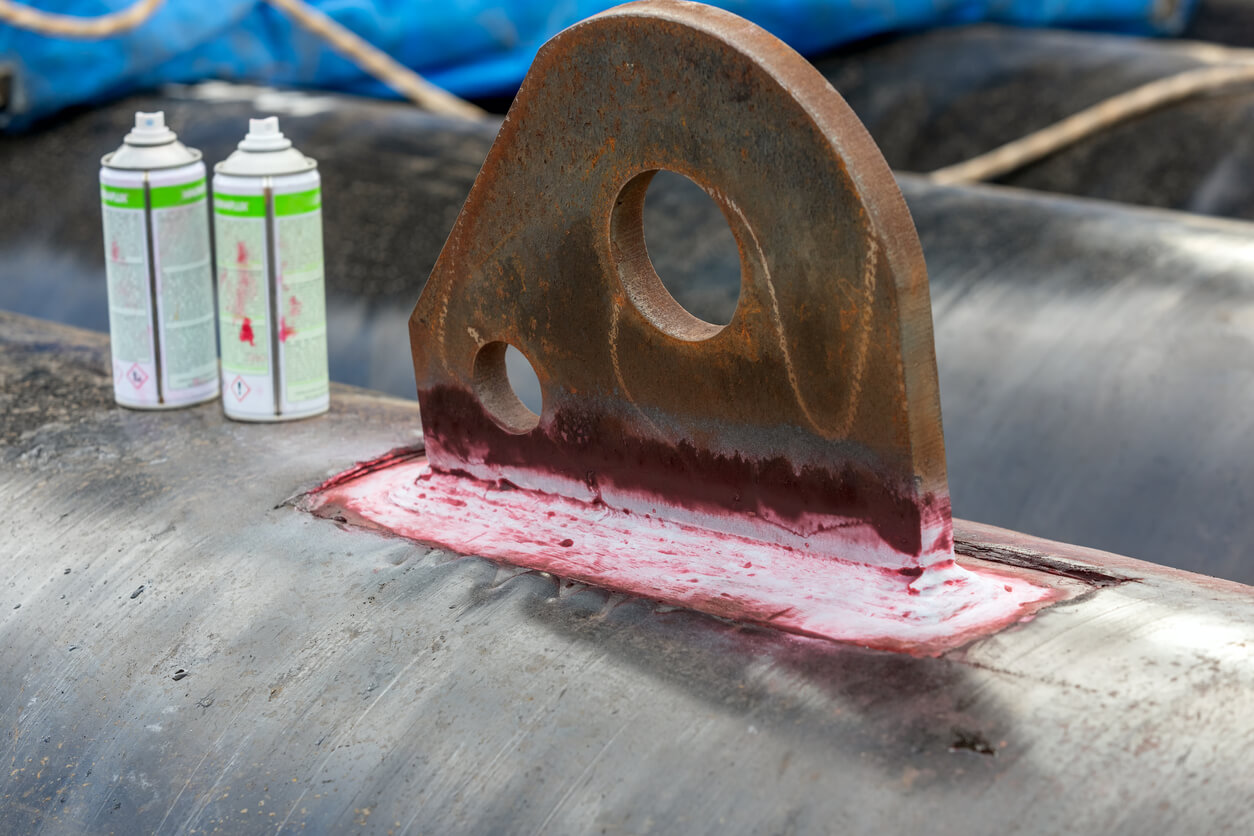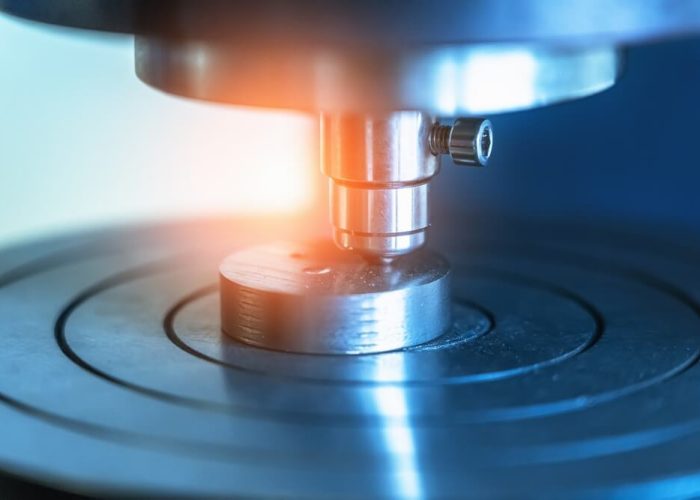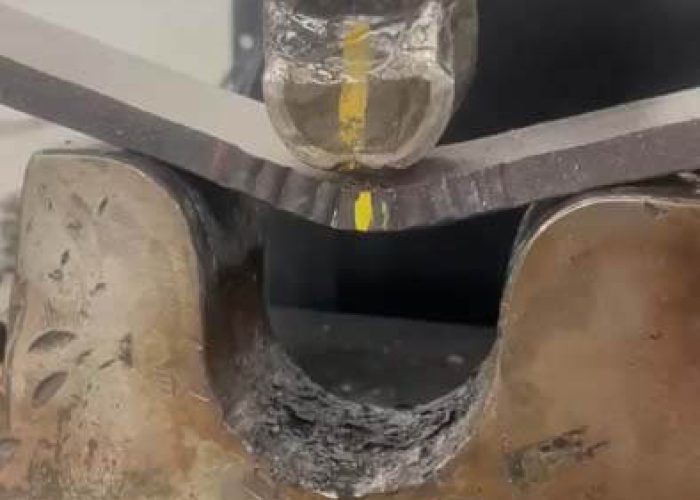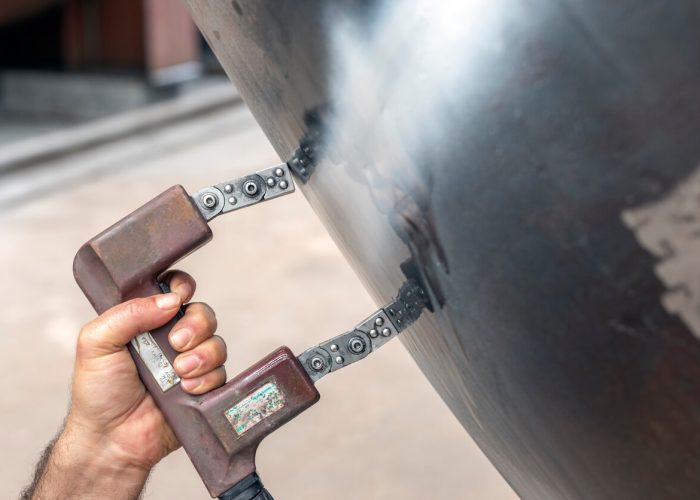Liquid Penetrant Testing PT Testing by WH Labs in Houston
We’ve established WH Labs as Houston’s premier facility for liquid penetrant testing, where we detect surface-breaking discontinuities with precision accuracy. Our state-of-the-art PT inspection systems can identify defects as small as 0.0001 inches using fluorescent or visible dye methods. When you’re dealing with critical components in aerospace, oil and gas, or power generation applications, you’ll want to understand how our advanced NDT capabilities guarantee both compliance and safety.

Key Points
- WH Labs offers advanced PT inspection systems with automated processing lines and LED UV-A illumination technology in their certified testing facility.
- The facility maintains strict environmental controls and meets NADCAP, ASTM, and ISO requirements for liquid penetrant testing.
- Certified Level II and Level III inspectors perform testing that complies with ASTM E1417 and ASME Section V Article 6.
- WH Labs serves oil & gas, aerospace, power generation, and manufacturing industries with specialized PT testing procedures.
- The lab provides precise defect detection down to 0.001″ with exhaustive documentation through automated processing lines.
The Science Behind Liquid Penetrant Testing
While many nondestructive testing methods exist, liquid penetrant testing (PT) relies on the fundamental principles of capillary action and surface tension.
When we apply a specially formulated penetrant to a test specimen’s surface, these physical forces drive the liquid into even microscopic discontinuities.
The remarkable power of physical forces enables specialized penetrants to reveal the tiniest flaws hidden beneath a test specimen’s surface.
We’ve found that the penetrant’s molecular properties, including its contact angle and surface wetting characteristics, determine how effectively it seeps into surface-breaking flaws.
After allowing sufficient dwell time, we remove excess penetrant and apply a developer.
The developer acts as a blotter, drawing the trapped penetrant from defects through reverse capillary action.
This process creates visible indications that we can evaluate under appropriate lighting conditions, whether using fluorescent or visible dye penetrants.
As one of the most cost-effective NDT methods, PT testing helps identify potential issues early while maintaining the structural integrity of the material.
WH Labs’ Advanced PT Testing Equipment and Facilities
At WH Labs, we’ve equipped our certified testing facility with advanced PT inspection systems that include automated processing lines and cutting-edge LED UV-A illumination technology.
Our state-of-art equipment incorporates precision-controlled spray application systems, automated development chambers, and digital imaging systems for enhanced flaw detection and documentation.
The facility maintains strict environmental controls for temperature, humidity, and ventilation while meeting all applicable industry specifications including NADCAP, ASTM, and ISO requirements.
We also provide comprehensive calibration services to ensure optimal performance and accuracy of all testing equipment.
State-of-Art PT Equipment
WH Labs maintains a thorough suite of state-of-the-art liquid penetrant testing equipment, featuring advanced Type 1 fluorescent and Type 2 visible dye penetrant systems.
We’ve equipped our facility with precision-controlled UV-A LED lamps, automated development chambers, and digital imaging systems for enhanced flaw detection.
Our penetrant line includes both water-washable and post-emulsifiable penetrants meeting AMS 2644 requirements.
We’ve installed automated processing lines with controlled wash stations, electrostatic spray systems, and temperature-monitored drying ovens.
Digital light meters and black light intensity monitors guarantee ideal inspection conditions.
We’re continually upgrading our equipment to incorporate the latest PT technology innovations.
Our calibrated measurement tools and certified reference panels help us deliver consistent, reliable results that meet industry specifications and your quality requirements.
Certified Testing Facility
Certified excellence defines our 15,000-square-foot liquid penetrant testing facility, which maintains ISO 17025 accreditation and Nadcap merit status.
We’ve designed our PT testing cells with controlled ambient conditions, including regulated temperature, humidity, and UV-filtered lighting systems.
Our dedicated processing lines incorporate automated immersion tanks, electrostatic spray application systems, and climate-controlled drying chambers.
We’re equipped with standardized inspection booths featuring calibrated UV-A lamps and white light sources that meet or exceed aerospace requirements.
You’ll find our quality control lab staffed by Level III certified technicians who monitor penetrant sensitivity, contamination levels, and washability parameters daily.
We’ve implemented a digital documentation system for real-time process control and complete testing traceability that aligns with industry specifications like ASTM E1417 and AMS 2647.
Industries Served by WH Labs in Houston
Operating from our Houston facility, we serve a diverse range of industrial sectors that require high-precision liquid penetrant testing and quality assurance.
We deliver advanced liquid penetrant testing from our Houston base, supporting diverse industries with precise quality validation services.
Our clientele spans critical infrastructure and manufacturing domains where surface defect detection is paramount to operational integrity.
Our thorough PT testing services support:
- Oil & Gas – Including pipeline components, pressure vessels, and wellhead equipment requiring ASME compliance
- Aerospace – Supporting FAA-regulated components, turbine parts, and critical airframe structures
- Power Generation – Serving nuclear, fossil fuel, and renewable energy facilities with ASNT-compliant inspections
- Manufacturing – Testing precision-machined components, castings, and fabricated assemblies for automotive and industrial applications
We maintain specialized certifications and equipment calibrations specific to each industry’s regulatory requirements and quality standards.
Our comprehensive approach includes visual inspection methods as a crucial first step in identifying potential surface defects before conducting penetrant testing.
Quality Assurance and Testing Standards
To maintain the highest level of inspection reliability, our liquid penetrant testing protocols strictly adhere to industry-recognized standards including ASTM E1417, ASME Section V Article 6, and NADCAP checklist requirements.
We’ve implemented a thorough quality management system that guarantees consistent results across all PT inspections. Our quality assurance program integrates multiple layers of verification, including daily system performance checks, calibrated light meters, and temperature monitoring equipment.
We document all inspections with detailed reports that meet AMS 2647 requirements. Our certified Level II and Level III inspectors maintain active SNT-TC-1A certifications and undergo regular performance evaluations.
We’re committed to exceeding our clients’ expectations through rigorous process controls, validated procedures, and meticulous record-keeping that satisfy both regulatory compliance and customer specifications.
Our dedication to ISO 9001 certification demonstrates our commitment to maintaining standardized processes and ensuring reliable testing outcomes.
Benefits of Choosing WH Labs for PT Testing
While many labs offer basic PT testing services, WH Labs delivers thorough penetrant testing solutions backed by decades of specialized experience and cutting-edge equipment.
We recognize that your components require meticulous inspection to maintain operational integrity and safety compliance.
- Our Level III certified technicians utilize advanced fluorescent and visible penetrants, delivering precise defect detection down to 0.001″ with exhaustive documentation
- We’re equipped with automated processing lines and custom-designed inspection booths featuring UV-A LED technology for superior sensitivity
- Our expedited 24-hour turnaround capability keeps your projects on schedule without compromising quality
- We maintain NADCAP accreditation and comply with AMS 2644 specifications, ensuring your components meet aerospace, automotive, and industrial standards
Trust your critical components to our proven expertise and industry-leading facilities.
Non-destructive testing methods like PT testing help prevent catastrophic failures by revealing hidden flaws and weaknesses in critical components.
Common Applications and Case Studies
Throughout our years of PT inspection services, we’ve documented numerous success stories across aerospace, automotive manufacturing, and critical infrastructure projects.
Our technicians regularly identify subsurface defects in welded components, castings, and forged materials that could have led to catastrophic failures if left undetected.
These real-world applications demonstrate how our PT testing protocols have helped clients maintain strict quality control standards while ensuring regulatory compliance in their specific industries.
Our commitment to ISO 9001 accreditation ensures we maintain the highest standards of quality management and testing accuracy for all inspection services.
Industry Success Stories
Since its widespread adoption across manufacturing sectors, liquid penetrant testing has demonstrated remarkable success in identifying critical surface defects.
Our team at WH Labs has witnessed firsthand how PT testing transforms quality assurance processes across industries.
Let’s explore some notable success stories where PT testing made a significant impact:
- An aerospace manufacturer detected microscopic stress cracks in turbine blades, preventing potential in-flight failures and saving millions in liability costs
- A petrochemical facility’s routine PT inspection revealed previously undetected weld discontinuities in critical pressure vessels, averting potential catastrophic failures
- An automotive parts supplier implemented automated PT testing, reducing defect escape rates by 98% while increasing throughput
- A medical device manufacturer utilized fluorescent PT to validate surgical instrument integrity, achieving full FDA compliance and zero product recalls
Common Inspection Scenarios
Manufacturing scenarios commonly requiring liquid penetrant testing span diverse applications and unique inspection challenges. We regularly perform PT testing on welded joints, castings, and forgings to detect surface-breaking discontinuities.
In aerospace components, we inspect turbine blades, landing gear parts, and structural elements for fatigue cracks and stress-induced defects. Our petrochemical industry work focuses on pipeline welds, pressure vessel seams, and valve bodies where surface flaws could compromise integrity.
We’ve developed specialized procedures for examining thin-wall components, complex geometries, and challenging material surfaces. Whether it’s detecting hairline cracks in precision machined parts or identifying porosity in critical safety components, we’ll tailor our PT inspection approach to your specific material and acceptance criteria while maintaining full compliance with industry standards.
Frequently Asked Questions
How Long Does a Typical Liquid Penetrant Testing Procedure Take to Complete?
We complete standard liquid penetrant testing in 45-60 minutes, including surface preparation, penetrant application, dwell time, developer application, and final inspection following ASTM E1417 testing protocol.
Can Liquid Penetrant Testing Be Performed in Wet or Humid Conditions?
We can’t perform penetrant testing in wet or humid conditions, as moisture interferes with penetrant surface tension and capillary action. We must maintain dry surface conditions for reliable flaw detection.
What Is the Minimum Size of Defect That PT Testing Can Detect?
We can typically detect surface defects as small as 0.5 microns wide and 10 microns deep through PT testing, though ideal conditions and proper technique are essential for this sensitivity level.
Is Liquid Penetrant Testing Safe for All Types of Metal Surfaces?
We can’t safely apply PT testing to all metals. Special care’s needed for porous metals, and we must avoid using penetrants on hot surfaces or materials that could react chemically with inspection fluids.
How Soon After Welding Can Penetrant Testing Be Performed?
We recommend waiting until welds cool below 125°F (52°C) before performing penetrant testing. Immediate testing on hot surfaces can compromise penetrant sensitivity and evaporate the inspection materials prematurely.
Takeaway
We’ve proven ourselves as Houston’s premier liquid penetrant testing provider through our state-of-the-art Type II fluorescent penetrant systems and rigorous ASTM E1417 compliance. Our NDT Level III certified technicians deliver precise surface discontinuity detection across aerospace, petrochemical, and power generation components. With our automated processing lines and expert defect interpretation capabilities, we’ll continue advancing PT testing excellence for critical industrial applications.



